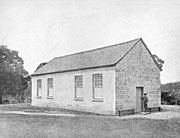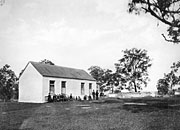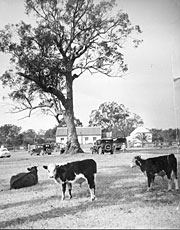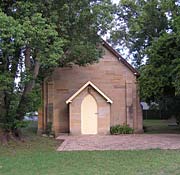
Historic Ebenezer Church - since 1809
Our Heritage
Historical Background
Ebenezer ChurchEbenezer Church came into being following the arrival in the colony of New South Wales of eight families on board the ‘Coromandel’ in June 1802. These families – Davison, Hall, Howe, Johnston, Johnstone, Mein, Stubbs and Turnbull – came to the new colony with a request to be settled together. Their wish was granted by Governor King and they moved to their 100-acre land grants at Portland Head (Ebenezer) on the Hawkesbury River early in 1803. They were joined by seven other families – Arndell, Bushell, Grono, Cavanough, Jacklin, Suddis and Jones – and met regularly on Sundays for services on Ebenezer Mount or in the homes of settlers. One of their members, James Mein, led the group in prayers and hymns. These settlers were people of various denominations but they came together as one congregation. In 1808 at a special meeting in the home of Dr Thomas Arndell, a surgeon who came out on the First Fleet, each family pledged itself to the building of a church and school. The total cost of £400 was to be obtained from voluntary subscriptions. There was no assistance by way of finance or labour from the government. Pioneer Owen Cavanough donated four acres of land on which to build the church. Andrew Johnston designed the church and supervised its construction. George Hall swam his bullocks across the river to haul the stone to the site. Built of locally obtained materials – sandstone, cedar wood and hardwood – it was constructed in 1809. Despite their general lack of agricultural background the settlers of Portland Head were to become successful farmers and were to make a major contribution to the Hawkesbury community and the colony. When Governor Lachlan Macquarie visited Portland Head by river on 4th December 1810 he was impressed with their progress for he recorded in his diary: ‘The farms on both banks, especially those on the left bank, are rich and well cultivated, and make a pretty appearance from the water, being generally interspersed with extensive orchards of peaches and other fruits.’ Under the leadership of Presbyterian James Mein, and also due to the influence of the Reverend John Dunmore Lang from Sydney town, Ebenezer Church became the first Presbyterian Church in Australia. The building was originally divided by a cedar partition into two rooms, one used for church services and the other as a school. The school began in 1810 under schoolmaster John Youl and remained open with teachers such as John Anderson, an ex-convict transported for his involvement in the Scottish Uprising of 1820, and Matthew McFetridge until 1887 when a new public school opened. The first ordained minister was Reverend John McGarvie who agreed to migrate to the colony from Scotland in 1825. Prior to this time they were led by ‘Pastor’ James Mein and intinerant preachers, especially Rowland Hassall and John Youl of the London Missionary Society.Ebenezer Church, the oldest existing church in Australia, is still an active church today. |
|
Ebenezer Church - Summary of our Heritage
- Is Australia’s oldest church, est. 1809
- Was the first non-conformist then Presbyterian Church in Australia.
- Was a pioneer in education in the colony, beginning a school in 1810. The church is the oldest extant school building in Australia.
- The Coromandel covenantors arrived in Sydney in 1802 and began as pioneer farmers on the Hawkesbury at Portland Head in 1803.
- After five years of worship in the open air and in the homes of Dr Arndell and Owen Cavanough they, with seven other families, covenanted on the 22 nd September 1808. They formed the ‘Society for the Propagation of Christian Knowledge and the Instruction of Youth’ and agreed to build a church and school and to call a minister to facilitate their faith.
- Ebenezer means ‘The Lord has helped us all the way’ or ‘Stone of Help’. 1 Samuel: Chapter 7 Verse 12.
- In 1809 and 1817 they sent to the London Missionary Society for supply of a minister.
- The first communion service according to the Church of Scotland was conducted in 1824 by the Rev. Dr. John Dunmore Lang. Andrew Johnston was ordained as an elder.
- The schoolmaster’s residence appears to have been built in 1817 and is an excellent example along with the church of early colonial architecture designed by Andrew Johnston.
- David Dunstan and later Charles Smith, carpenter for Governor Macquarie and architect Greenway, did the carpentry at Ebenezer Church.
- The first ordained Minister to serve at Ebenezer was the Rev. Dr John McGarvie, taking over pastoral duties from layman Catechist ‘Pastor’ James Mein.
- The fifteen pioneer families made major contribution not only to church life but also to the whole development of the colony in its infancy.
Scots Church, Pitt Town
For information on the history of Scots Church Pitt Town we are grateful to R. M. Arndell, historian and parish session clerk, who produced a short history for the occasion of the centenary in 1962. He endeavoured to do this ‘in the hope that it will arouse some interest in our heritage and strengthen our dedication to the Christian Life.’ Prior to the building of this church the Presbyterian families living on the Pitt Town side of the Hawkesbury worshipped at Ebenezer. Transport was mainly by rowboat, but those fortunate to possess a horse, or horse and sulky or buggy, could cross the river by punt at the foot of Bathurst Street, Pitt Town, and from there a track wound its way to Ebenezer Church. William Hall of ‘Percy Place’ saw the need for a place of worship in Pitt Town and made it possible for Scots Church to be built free of debt. The tablet in the church in memory of William Hall states: ‘He was distinguished through life for his integrity and uprightness. He was a kind friend to the poor, and contributed largely to the erection and permanent endowment of this church.’ The church was built of solid blocks of Hawkesbury sandstone. The blocks were fourteen inches (350mm) thick and were quarried 5km from Pitt Town at Longneck. The huge hardwood trusses supporting the steeply-pitched slate roof were fashioned with axe and adze. All the furnishings were made of cedar. Scots Church Pitt Town was dedicated on 25 May 1862, the congregation ‘very numerous’ and the Reverend Craig of Parramatta preaching a ‘very edifying and impressive sermon’ on the occasion. The parish minister at the time was the Reverend George MacFie. |
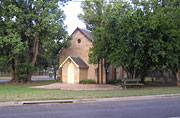
|
